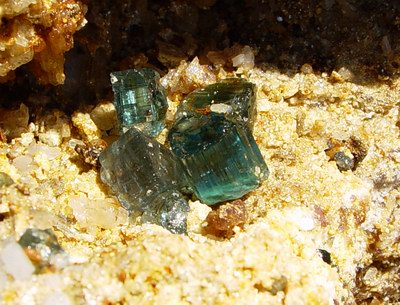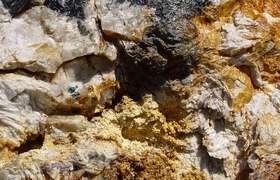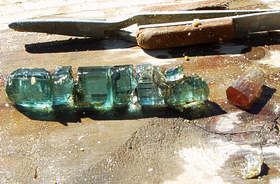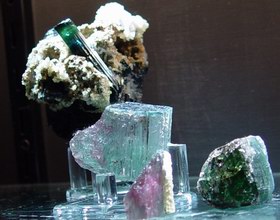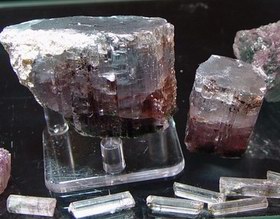The thickening pegmatite, described in the preceding page, was
proving to be a mixed blessing as now it required us to drill at least
12 to 15 feet into the pegmatite to assure the blast would occur below the
pocket zone. The pocket zone in this area was 8-10 feet below the
upper contact. So as not to simply kick out the bottom of the holes
leaving the upper portion still in place, we now had to deck our holes
when loading them. With this method we would place a small amount of
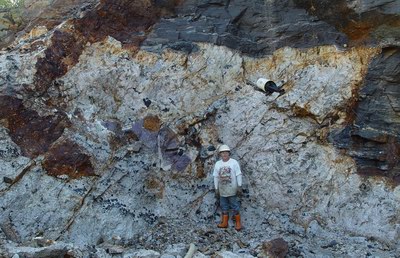 explosive
in the bottom portion of the hole with the electric
detonator. We would follow this by adding stemming material, crushed
rock, to the hole in order to fill the section we believed penetrated
the pocket zone. Above this we would add more explosive and finally
more stemming to finish loading the hole. To assure that the detonation
'signal' was transmitted to the upper layer of explosive, we would
connect the sections, the decks, by means of detonator cord. The
electric detonator in the lower section would initiate the 'det' cord
which
in turn would set off the explosive loaded in the upper deck. By this
means we generally got a
clean face and with luck protected the better mineralized area from
direct exposure to the detonation. A well executed shot would eject the
top and bottom decks and drop the better material in a heap on the pit
floor in front of the working face. That's the theory anyway. In
practice the pegmatite would at times break along the cleavelandite
zone overlaying the garnet line and most or all of the lower deck would
remain in place. This especially happened when the area was better
mineralized as the albite (cleavelandite) layer was thicker and hence
weaker. This created 'toes' or projections of rock at the bottom
of our face which need to be drilled and shot again. explosive
in the bottom portion of the hole with the electric
detonator. We would follow this by adding stemming material, crushed
rock, to the hole in order to fill the section we believed penetrated
the pocket zone. Above this we would add more explosive and finally
more stemming to finish loading the hole. To assure that the detonation
'signal' was transmitted to the upper layer of explosive, we would
connect the sections, the decks, by means of detonator cord. The
electric detonator in the lower section would initiate the 'det' cord
which
in turn would set off the explosive loaded in the upper deck. By this
means we generally got a
clean face and with luck protected the better mineralized area from
direct exposure to the detonation. A well executed shot would eject the
top and bottom decks and drop the better material in a heap on the pit
floor in front of the working face. That's the theory anyway. In
practice the pegmatite would at times break along the cleavelandite
zone overlaying the garnet line and most or all of the lower deck would
remain in place. This especially happened when the area was better
mineralized as the albite (cleavelandite) layer was thicker and hence
weaker. This created 'toes' or projections of rock at the bottom
of our face which need to be drilled and shot again. Pocket 17 was discovered during one of these toe removal operations. The blast that had exposed pocket 16 left us with a substantial toe. While shooting this toe and one hole in the next bench, we managed to spread the contents of pocket 17 well out into the pit. Smaller crystals are generally not damaged when they are ejected but large ones are. 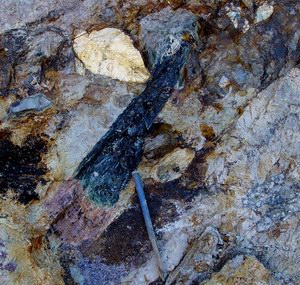 In
this case very nice large smoky quartz groups were either broken or
chipped. Besides the damage, the pocket contents become interspersed
with the rest of the rock blasted making recovery challenging. We were
still picking up pink tourmalines more than a week later. In
this case very nice large smoky quartz groups were either broken or
chipped. Besides the damage, the pocket contents become interspersed
with the rest of the rock blasted making recovery challenging. We were
still picking up pink tourmalines more than a week later. As mentioned , the pink tourmaline pockets occurred just as the pegmatite started to thicken. They were in the transition zone between the down strike thin segment and the up strike thicker one. Once we entered the thicker part there was a brief zone of dry pegmatite. In the picture above, the dry zone is just to the right of Richard. The pink producing area is just to the right of his feet. This dry area appears to be very similar to the pegmatite below the garnet line and above the lower contact. The zone appears almost as is reacting to the vertical contact as is it were the lower one. Notice the area of fine grained lepidolite to left of Richard. Pockets we found associated with this intensely mineralized area had undergone substantial replacement. One pocket in particular, MMP19-04, contained numerous etched fragments of what was once a large and probably spectacular tourmaline. The colors ran the gamut from red to blue to green and an unusual cinnamon color. The pieces, some quite large and gemmy, were reminiscent of some of the delicately etched beryls from the Orchard quarry. In the image to the left a schorl has formed in this zone and becomes elbaite as it nears the lepidolite. There were many of these Li/Cs rich zone as we worked it down dip. The shiny object is a lepidolite rimmed mica book. We had no idea how thick this enriched zone would be. We soon discovered it was only 3-4 feet thick in the up strike direction but followed the transition from the thin pegmatite to the thicker as it progressed down dip. The next bench we put it across our face as we mined up strike was not a producer, but the following one was with the discovery of pocket 21 (MMP21-04) on September 22nd. The blast on that day peeled the front off of the pocket revealing a pile of golden cookeite and loose granular lepidolite. Another indicator that this was going to be a productive pocket was the large schorl that had developed in the roof. See the image to the left below.
Pockets 22 and 23 were found just to the left of Richard in the photo above and associated with the rusty area. MMP22-04 produced some dark blue tourmalines in a rusty cookeite matrix. A high pressure water gun could easily trim away this material to exposed the crystals within. Pocket 23 yielded some interesting pale blue nodular pieces with pinks accents. There was one gemmy green nodule as well. Pocket 24 emerged about 3-4 feet directly up strike from pocket 21. It seems that the larger tourmalines are the terminal ends of the schorls that grow from the ceiling down into the pocket.
Though thus far in this area we had not found a pocket on the scale pockets 7 and 11, the material we were finding was tantalizing. So much so in fact that I decided to take another 10' slice off of the schist overburden starting back down strike at the begining of the thickened area. I wanted very much to see more of the zone that was enriched in lithium and cesium. We had found one small area with pollucite. Perhaps there was more. The many spodumene crystals were intriguing as well. Would one of these be found in a pocket? A nice kunzite would not be hard to take. |
||||
